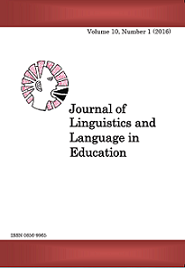The Relationship between Vocabulary Learning Strategies and Vocabulary Knowledge among Tanzanian Learners of Chinese
Abstract
This study investigates the relationship between the use of vocabulary learning
strategies and vocabulary knowledge. The participants in the study were 39
first-year students who had been enrolled on a Chinese language course at the
University of Dar es Salaam. Two measuring instruments were used to collect
the data: a vocabulary test and a vocabulary learning strategies questionnaire
ô€†ô€’ô€‘ô€–ô€Œô€–ô€—ô€Œô€‘ô€Šô€€ƒ ô€’ô€‰ô€€ƒ ô€–ô€—ô€•ô€„ô€—ô€ˆô€Šô€œô€€ƒ ô€Œô€—ô€ˆô€ô€–ô€€ƒ ô€„ô€‘ô€‡ô€€ƒ ô€„ô€‡ô€„ô€“ô€—ô€ˆô€‡ô€€ƒ ô€‰ô€•ô€’ô€ô€€ƒ ô€€¶ô€†ô€‹ô€ô€Œô€—ô€—ô€‚·ô€–ô€€ƒ ô€€‹ô€€”ô€€œô€€œô€€šô€€Œô€€ƒ ô€—ô€„ô€›ô€’ô€‘ô€’ô€ô€œô€€ƒ ô€’ô€‰ô€€ƒ
ô€™ô€’ô€†ô€„ô€…ô€˜ô€ô€„ô€•ô€œô€€ƒ ô€ô€ˆô€„ô€•ô€‘ô€Œô€‘ô€Šô€€ƒ ô€–ô€—ô€•ô€„ô€—ô€ˆô€Šô€Œô€ˆô€–ô€€ƒ ô€„ô€‘ô€‡ô€€ƒ ô€‰ô€•ô€’ô€ô€€ƒ ô€€¶ô€‹ô€ˆô€‘ô€‚·ô€–ô€€ƒ ô€€‹ô€€•ô€€“ô€€“ô€' ô€€Œô€€ƒ ô€€¦ô€‹ô€„ô€•ô€„ô€†ô€—ô€ˆô€•ô€€ƒ ô€€¯ô€ˆô€„ô€•ô€‘ô€Œô€‘ô€Šô€€ƒ
Strategy Inventory questionnaire. The findings reveal that the participants
actively used the vocabulary learning strategies. They also show that the
participants preferred strategies specific for learning over certain common
strategies. They also reveal that overall use of vocabulary learning strategies
ô€šô€„ô€–ô€€ƒô€“ô€’ô€–ô€Œô€—ô€Œô€™ô€ˆô€ô€œô€€ƒô€•ô€ˆô€ô€„ô€—ô€ˆô€‡ô€€ƒô€—ô€’ô€€ƒô€—ô€‹ô€ˆô€€ƒô€ô€ˆô€„ô€•ô€‘ô€ˆô€•ô€–ô€‚·ô€€ƒvocabulary knowledge.
References
ô€€¥ô€’ô€ƒ§ô€Œô€‘ô€’ô€™ô€Œô€ƒ¾ô€€ N. & Sindik, J. (2011). Gender Differences in the Use of
Learning Strategies in Adult Foreign Language Learners.
ô€€°ô€ˆô€—ô€’ô€‡ô€Œô€„€ô€Žô€Œô€€ƒ ô€€²ô€…ô€ô€’ô€•ô€Œô€€ô€€ƒ ô€ƒ¿ô€„ô€–ô€’ô€“ô€Œô€–ô€€ƒ ô€a Odgojno-Obrazovnu Teoriju i
Praksu, 6(11): 5􀂲20.
Catalan, R. M. J. (2003). Sex Differences in L2 Vocabulary Learning
Strategies. International Journal of Applied Linguistics, 13(1):
􀂲77.
Chen, M. J. & Yuen, J. C.-K. (1991). Effects of Pinyin and Script
Type on Verbal Processing: Comparisons of China, Taiwan,
and Hong Kong Experience. International Journal of
Behavioural Development, 14(4): 429􀂲448.
Deneme, S. (2010). Cross-Cultural Differences in Language Learning
Strategy Preferences: A Comparative Study. Language Society
and Culture.
Ehrman, M. E., Leaver, B. L. & Oxford, R. L. (2003). A Brief
Overview of Individual Differences in Second Language
Learning. System, 31(3): 313􀂲330.
Ellis, R. (1994). The Study of Second Language Acquisition. Oxford:
Oxford University Press.
Fernandes, M. A., Wammes, J. D. & Hsiao, J. H. (2013).
Representation of Linguistic Information Determines its
Susceptibility to Memory Interference. Brain Sciences, 3(3):
􀂲1260.
Grainger, P. (2012). The Impact of Cultural Background on the
Choice of Language Learning Strategies in the JFL Context.
System, 40(4): 483􀂲493.
Han, Y. (2014). Foreign Language Vocabulary Learning Strategies:
Patterns of Use among College Students (Auburn University).
Retrieved from
https://holocron.lib.auburn.edu/handle/10415/4304
| The Relationship between Vocabulary Learning Strategies and Vocabulary Knowledge
Huang, H.-S. & Hanley, J. R. (1995). Phonological Awareness and
Visual Skills in Learning to Read Chinese and English.
Cognition, 54(1): 73􀂲98.
Javid, C. Z., Al-thubaiti, T. S. & Uthman, A. (2013). Effects of
English Language Proficiency on the Choice of Language
Learning Strategies by Saudi English-Major Undergraduates.
English Language Teaching, 6(1): 35􀂲47.
Lesch, M. F. & Pollatsek, A. (1998). Evidence for the Use of
Assembled Phonology in Accessing the Meaning of Printed
Words. Journal of Experimental Psychology: Learning,
Memory, and Cognition, 24(3).
Loh, C. Y. R. & Teo, T. C. (2017). Understanding Asian Students
Learning Styles, Cultural Influence and Learning Strategies.
Journal of Education & Social Policy, 7(1): 194􀂲210.
ô€€²ô€‚·ô€ô€„ô€ô€ô€ˆô€œô€€ô€€ƒ ô€€ô€€‘ô€€ƒ ô€€°ô€€‘ & Chamot, A. U. (1990). Learning Strategies in
Second Language Acquisition. Cambridge: Cambridge
University press.
Oxford, R. L. (1996). Language Learning Strategies around the
World: Cross-Cultural Perspectives. Natl Foreign Lg Resource
Ctr.
Rahimi, M., Riazi, A. & Saif, S. (2008). An Investigation into the
Factors Affecting the Use of Language Learning Strategies by
Persian EFL Learners. Canadian Journal of Applied
Linguistics/Revue Canadienne de Linguistique Appliquée,
(2): 31􀂲60.
Read, J. (1993). The Development of a New Measure of L2
Vocabulary Knowledge. Language Testing, 10(3): 355􀂲371.
Schmitt, N. (1997). Vocabulary Learning Strategies. Vocabulary:
Description, Acquisition and Pedagogy, 199227.
Selinker, L. & Gass, S. M. (2008). Second Language Acquisition: An
Introductory Course. Taylor & Francis.
Shen, H. H. (2005). An Investigation of Chinese-Character Learning
Strategies among Non-Native Speakers of Chinese. System,
(1): 49􀂲68.
Tan, L. H., Spinks, J. A., Gao, J.-H., Liu, H.-L., Perfetti, C. A., Xiong,
J. & Fox, P. T. (2000). Brain Activation in the Processing of
Chinese Characters and Words: a Functional MRI Study.
Human Brain Mapping, 10(1): 16􀂲27.
Tavassoli, N. T. (1999). Temporal and Associative Memory in
Chinese and English. Journal of Consumer Research, 26(2):
􀂲181.
Cyprian T. K. Kilangi | 177
Winke, P. M., & Abbuhl, R. (2007). Taking a Closer Look at
Vocabulary Learning Strategies: A Case Study of a Chinese
Foreign Language Class. Foreign Language Annals, 40(4).
Wong, L. L. & Nunan, D. (2011). The Learning Styles and Strategies
of Effective Language Learners. System, 39(2): 144􀂲163.
Zhang, Y. (2011). The Use of Vocabulary Learning Strategies by
Good and Poor Language Learners: A Case Study of Chinese
Non-English Major Sophomores (Kristianstad University).
Retrieved from
Downloads
Published
Issue
Section
License
Copyright © by Department of Foreign Languages and Linguistics, University of Dar es Salaam
All rights reserved. No part of this publication may be reproduced or transmitted in any form or by any means, electronic or mechanical, including photocopying, recording, or any information storage or retrieval system, without permission in writing from the publisher, except for short extracts in fair dealing, for research or private study, critical scholarly review or discourse with an acknowledgement.



